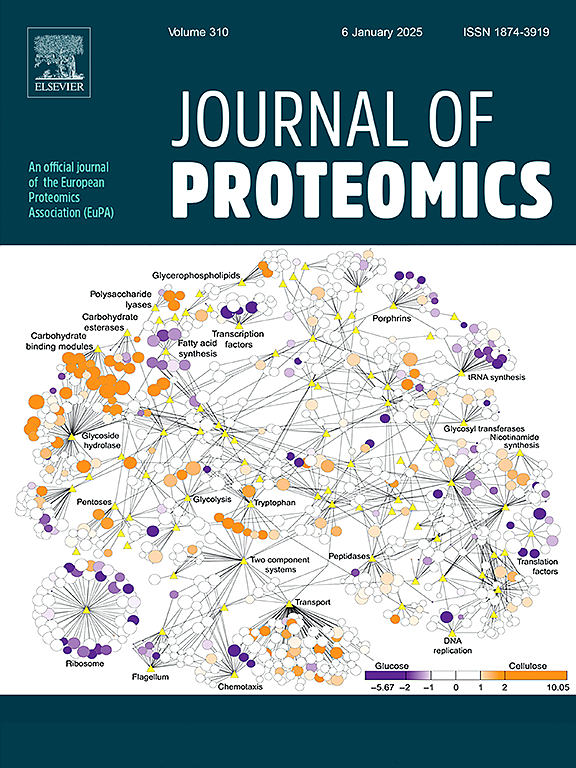Revisiting toxins with transcriptomics-informed proteomics of venom glands and crude venom from Centruroides bicolor from Panama
IF 2.8
2区 生物学
Q2 BIOCHEMICAL RESEARCH METHODS
引用次数: 0
Abstract
The sting of the scorpion Centruroides bicolor causes a large morbidity in Panama. To characterize its venom, transcriptomic and proteomic analyses of the venom glands and the crude venom were performed. These two approaches utilized high-throughput sequencing to enhance the likelihood of detecting a wide range of venom proteins correlated with the venom proteome. After RNA venom gland extraction, a cDNA library was constructed and sequenced by RNA-seq. Also, the crude venom was digested using trypsin and chymotrypsin, and the resulting peptides were analyzed using a nano-LC-MS/MS. Notably, transcriptomic and proteomic venom approaches identified a hyaluronidase, alpha- and beta-neurotoxins that affect Na+ channels, CRISP proteins, metalloproteinases, transferrin, monooxygenase alpha-peptidyl-glycine, serine proteases, alpha pancreatic amylase, lysozyme, neurotoxins targeting K+ channels, neprilysin, scorpine, angiotensin-converting enzyme, insulin-like growth factor-binding domain proteins, nucleobindin-like proteins, and uncharacterized proteins. Interestingly, some of the venom proteins such as nucleobindin and angiotensin-converting enzymes have been not reported in the proteome, their predicted presence has only been previously derived from the genomic sequence of Centruroides sculpturatus and C. vittatus. These newly identified components enhance the understanding of the venomous nature of C. bicolor.
Significance
The proteins and peptides found in Centruroides bicolor venom by transcriptomic and proteomic analyses were assessed according to the protein and toxin databases available on public domains. Notably, some of the venom proteins such as nucleobindin and angiotensin-converting enzymes have been not reported in the proteome, their predicted presence has only been previously derived from the genomic sequence of Centruroides sculpturatus and C. vittatus. Moreover, enzymatic assays, including hyaluronidase, phospholipase A2, and proteolytic activity were conducted to confirm the presence or absence of those enzymes. Interestingly, neurotoxins from C. limbatus, a related species in the region, were found in the proteome but no mRNAs were identified in the transcriptome. These newly identified components enhance the understanding of the venomous nature of Centruroides bicolor.

用转录组学重新研究巴拿马双色棘豆毒腺和粗毒液的蛋白质组学。
双色蝎子的螫伤在巴拿马引起了很大的发病率。为了表征其毒液,对毒腺和粗毒液进行了转录组学和蛋白质组学分析。这两种方法利用高通量测序来提高检测与毒液蛋白质组相关的广泛毒液蛋白质的可能性。提取毒腺RNA后,构建cDNA文库并进行RNA-seq测序。用胰蛋白酶和胰凝乳蛋白酶消化粗毒液,用纳米lc -MS/MS分析所得肽。值得注意的是,转录组学和蛋白质组学方法鉴定了透明质酸酶、影响Na+通道的α -和β -神经毒素、CRISP蛋白、金属蛋白酶、转铁蛋白、单加氧酶-肽酰甘氨酸、丝氨酸蛋白酶、α胰淀粉酶、溶菌酶、靶向K+通道的神经毒素、neprilysin、scorpine、血管紧张素转换酶、胰岛素样生长因子结合域蛋白、核蛋白样蛋白和未表征蛋白。有趣的是,一些毒液蛋白如核结合蛋白和血管紧张素转换酶在蛋白质组中没有报道,它们的预测存在只是先前从雕刻Centruroides和C. vittatus的基因组序列中得到的。这些新鉴定的成分增强了对双色藤毒性的认识。意义:通过转录组学和蛋白质组学分析,对双色蜈蚣毒液中的蛋白质和多肽进行评估,并根据公共领域的蛋白质和毒素数据库进行评估。值得注意的是,一些毒液蛋白,如核结合蛋白和血管紧张素转换酶,在蛋白质组中没有报道,它们的预测存在只是先前从雕刻Centruroides和C. vittatus的基因组序列中得到的。此外,进行酶分析,包括透明质酸酶、磷脂酶A2和蛋白水解活性,以确认这些酶的存在或不存在。有趣的是,在蛋白质组中发现了来自该地区相关物种C. limbatus的神经毒素,但在转录组中没有发现mrna。这些新发现的成分增强了对双色棘豆毒性的认识。
本文章由计算机程序翻译,如有差异,请以英文原文为准。
求助全文
约1分钟内获得全文
求助全文
来源期刊

Journal of proteomics
生物-生化研究方法
CiteScore
7.10
自引率
3.00%
发文量
227
审稿时长
73 days
期刊介绍:
Journal of Proteomics is aimed at protein scientists and analytical chemists in the field of proteomics, biomarker discovery, protein analytics, plant proteomics, microbial and animal proteomics, human studies, tissue imaging by mass spectrometry, non-conventional and non-model organism proteomics, and protein bioinformatics. The journal welcomes papers in new and upcoming areas such as metabolomics, genomics, systems biology, toxicogenomics, pharmacoproteomics.
Journal of Proteomics unifies both fundamental scientists and clinicians, and includes translational research. Suggestions for reviews, webinars and thematic issues are welcome.
 求助内容:
求助内容: 应助结果提醒方式:
应助结果提醒方式:


